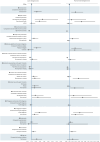Trend and Associated Factors for Late and Advanced HIV Diagnoses in 2011-2022 in Melbourne, Australia
- PMID: 40464595
- PMCID: PMC12135748
- DOI: 10.1002/jmv.70430
Trend and Associated Factors for Late and Advanced HIV Diagnoses in 2011-2022 in Melbourne, Australia
Abstract
Late- and advanced HIV diagnoses remain significant challenges worldwide. Understanding the factors associated with and testing practice among those with late (CD4 < 350 cells/µL) and advanced diagnoses (CD4 < 200 cells/µL) is essential to diminish AIDS-related morbidity and mortality. This retrospective study manually reviewed e-medical records of new HIV diagnoses between 2011 and 2022 at Melbourne Sexual Health Centre, Australia. Among 606 new diagnoses, 25% (152/606) were late, 11% (65/606) were advanced, and 94% (568/606) were men who have sex with men. Among 352 overseas-born individuals, late or advanced diagnoses increased from 22% (4/18) in 2011 to 56% (5/9) in 2022. No significant change was observed among Australian-born individuals. Late diagnoses were associated with being born in Latin America or in East Asia and Pacific, having no prior sexually transmitted infection (STI) diagnosis in their lifetime, and no drug use in their lifetime. Advanced diagnoses were associated with being born in East Asia and the Pacific, having no prior STI, older age, Medicare-ineligibility, and unknown condom use history in the last year. Key barriers to earlier testing included LGBT-related stigma (n = 41) and recent arrival (< 5 years) in Australia (n = 41). The primary risk for contracting HIV was condomless anal sex (n = 80). To conclude, one in three new HIV diagnoses was late or advanced, with increased risk among overseas-born, Medicare-ineligible or those with perceived low risk. Tailored campaigns for these underserved populations are urgently needed to promote timely HIV testing.
Keywords: AIDS; HIV; HIV diagnoses; HIV testing; advanced HIV diagnosis; late HIV dianogsis.
© 2025 The Author(s). Journal of Medical Virology published by Wiley Periodicals LLC.
Conflict of interest statement
The authors declare no conflicts of interest.
Figures



Similar articles
-
Trends in late and advanced HIV diagnoses among migrants in Australia; implications for progress on Fast-Track targets: A retrospective observational study.Medicine (Baltimore). 2020 Feb;99(8):e19289. doi: 10.1097/MD.0000000000019289. Medicine (Baltimore). 2020. PMID: 32080144 Free PMC article.
-
Disparities in characteristics in accessing public Australian sexual health services between Medicare-eligible and Medicare-ineligible men who have sex with men.Aust N Z J Public Health. 2020 Oct;44(5):363-368. doi: 10.1111/1753-6405.13029. Epub 2020 Aug 31. Aust N Z J Public Health. 2020. PMID: 32865864
-
Differences Between Men Who Have Sex with Men (MSM) with Low CD4 Cell Counts at Their First HIV Test and MSM with Higher CD4 Counts in Bangkok, Thailand.AIDS Behav. 2016 Dec;20(Suppl 3):398-407. doi: 10.1007/s10461-016-1456-0. AIDS Behav. 2016. PMID: 27329100
-
Prevalence of HIV indicator conditions in late presenting patients with HIV: a missed opportunity for diagnosis?QJM. 2019 Jan 1;112(1):17-21. doi: 10.1093/qjmed/hcy223. QJM. 2019. PMID: 30295832
-
Late presentation to HIV care despite good access to health services: current epidemiological trends and how to do better.Swiss Med Wkly. 2016 Aug 21;146:w14348. doi: 10.4414/smw.2016.14348. eCollection 2016. Swiss Med Wkly. 2016. PMID: 27544642 Review.
References
-
- Joint United Nations Programme on HIV/AIDS , The Urgency of Now: AIDS at a Crossroads, Joint United Nations Programme on HIV/AIDS, 2024, https://www.unaids.org/sites/default/files/media_asset/2024-unaids-globa....
-
- Kirby Institute, University of New South Wales , HIV, Viral Hepatitis and Sexually Transmissible Infections in Australia: Annual Surveillance Report, 2023, https://www.kirby.unsw.edu.au/sites/default/files/documents/Annual-Surve....
-
- Mcgregor S., “National HIV Notifications Post Covid,” Oral session presented at: Australasian HIV/AIDS 2024 conference, Sydney, Australia, September 16, 2024.
MeSH terms
LinkOut - more resources
Full Text Sources
Medical
Research Materials

